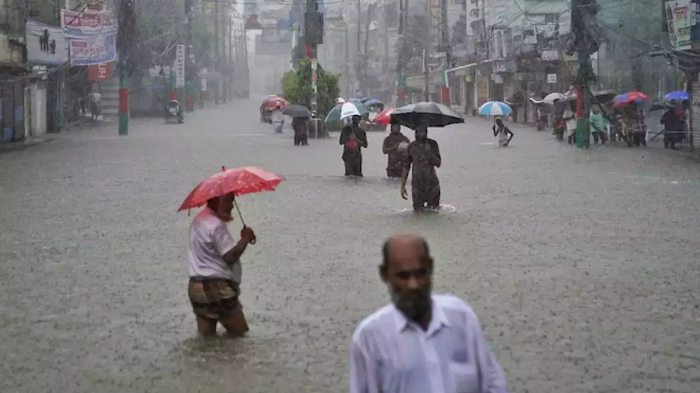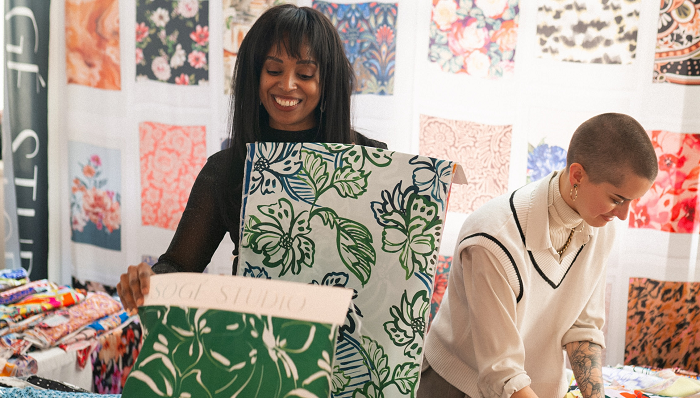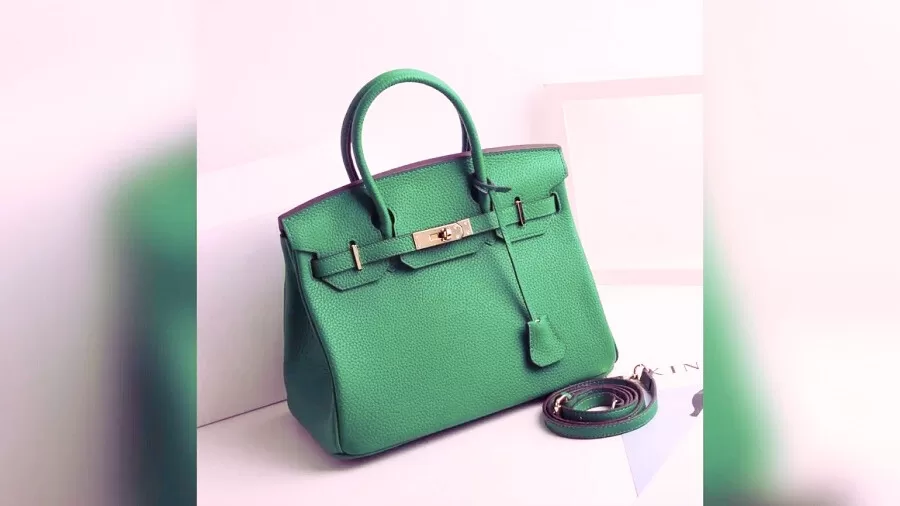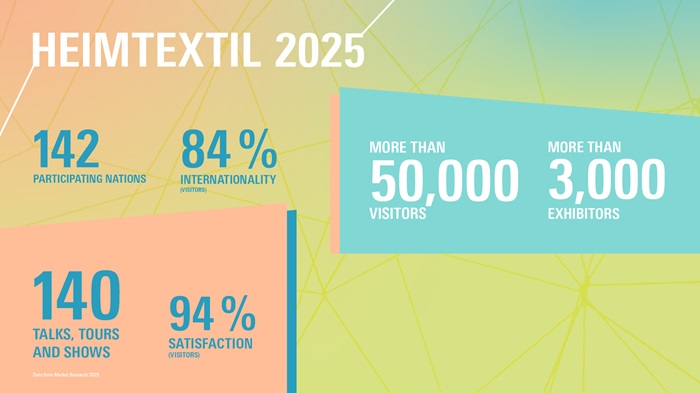FW
ITMA 2015 will be held November 12 to 19, 2015, Milan, Italy. This is the only exhibition worldwide featuring the largest and most comprehensive range of textile and garment technology products and services in one venue.
The fiber and yarn section has over the years got a lot of attention. Fiber and yarn producers have an integrated business platform. It attracts an international pool of buyers sourcing for end-to-end solutions for production of traditional textile materials. This section debuted at ITMA 2011. And ITMA 2015 will increase its focus on recycled fibers and yarns, a move said to be motivated by a growing commitment in the clothing and textiles industry to increasingly invest in environmentally friendly and sustainable production methods.
ITMA has been the world’s most established textile and garment machinery exhibition since 1951. The show is held every four years in alternating European countries. ITMA 2015 returns to Milan after a gap of 20 years. Milan will use the opportunity to reaffirm the quality of Italian products, which are well known for their high level of technology content, reliability and creativity. Italy’s textile machinery exports account for 78 per cent of its total sales and are shipped to around 130 countries.
www.itma.com/
Mills in China have lowered their demand for imported cotton this year because of fears that Beijing will issue fewer import quotas this year. China is the world’s top buyer of cotton. For three years, the country was stockpiling program. Now it wants to encourage consumption of its huge domestic stockpile of fiber at the expense of imports.
Right now, its cotton reserves are about 12.7 million tons, equivalent to almost 60 per cent of global stocks. With so much in reserves, the government is unlikely to issue more import quotas. So there is a strong urge for Beijing to de-stock. Without offering quotas, demand at reserve sales would be tepid. Prices have dropped below 17,000 yuan per ton but that price is 17 per cent less than the reserve's current purchase price.
Imports of Indian cotton for instance are expected to fall from February. What happens next depends on whether China releases additional quotas in subsequent months. But China has already imported several thousand tons of cheap Indian cotton.
In the absence of sufficient import quotas, mills could turn to yarn instead. Imports of yarn are not restricted by quotas and are subject to low import duties.
With the onset of rains, farmers in Ethiopia are set to plant genetically modified (GM) cotton seedlings. This is part of the government’s strategy to boost textile and garment exports.
Ethiopia has embarked on an ambitious five-year economic plan to boost textile and garment exports to meet a target of $1 billion by 2015. Ethiopia exports both cotton fabric and cotton garments.
The hope is that GM cotton will achieve higher yields than conventional varieties. GM crops are also supposed to be more resilient in the face of climate change. In some instances GM crops have not shown to have any negative ecosystem or environmental impacts. But there are activists who oppose the use of genetically modified technology in food production. They say conventional R&D can improves the productivity of locally adapted crops. They say conventional breeding programs can be devised to produce robust improved seed with greater genetic tolerance to heat stress, colder temperatures, drought and water logging. Bt cotton growers in India, in Tamil Nadu in particular, have suffered major losses from a new, unknown disease that has attacked their crops.
In December 2013, Pakistan’s textile exports increased by 22.4 per cent, despite slow economy. Perhaps what contributed to this upturn is the constant energy supply the government guaranteed, especially in Punjab. The current textile export rate is meeting government’s targets. If uninterrupted energy supply is continued, estimations are that Pakistan will be able to double its textile exports over four years. However, the refunds from the government need to be improved to reach the set goals.
In the first half of 2013 (July-December) Pakistan’s textile and clothing exports improved by 8.36 per cent. In terms of added value, particularly bedding witnessed a rise of 21.72 per cent, knitwear 5.35 per cent, readymade garments 7.9 per cent, cotton cloth 6.1 per cent and export of made ups went up 18.09 per cent. On the other hand the export of cotton yarn declined by 3.1 per cent. Total export proceeds grew by 5.11 per cent.
Ellaassay, a top women’s wear brand from China has chosen Lectra Fashion PLM to support its brand management and global business strategy. Lectra, the world leader in integrated technology solutions is dedicated to industries using soft materials like fabrics, leather, technical textiles and composite materials.
Ellasassay creates elegant, haute couture, developed using sophisticated fabric and apparel technologies. The company insists on a very high level of product quality therefore it invests heavily in technology as well as in international design talent. The company’s goal is to grow into a Chinese fashion brand that influences both the domestic and international stage. They are the first Chinese haute couture brand to participate in New York Fashion week, presenting at the event’s main venue.
Ellaassay designs and develops 80 per cent products in-house and manufactures their entire range themselves. Lectra Fashion PLM will help it improve collaboration between its design, development and production teams. With Lectra’s Fashion Platform, each department will be able to work with the same information in real-time. Lectra Fashion PLM will also help the company better control workflow and collection planning. By allowing Ellassay to manage the entire fashion development process with a comprehensive solution, Lectra Fashion PLM will help the company optimize costs.
www.ellassay.com/en/main.htm
www.lectra.com
The garment industry in Cambodia is largest foreign currency earner for the country. It reported a 20 per cent rise in exports last year, according to the figures of the Ministry of Commerce. The Southeast Asian nation exported apparel products worth 5.53 billion dollars, up by 20 per cent from 4.61 billion dollars a year earlier.
Garment products have been mostly sold to the United States and European countries, and some Asian countries, particularly Japan, China, and South Korea.Last year, apparel exports to the United States went up by 7.6 per cent, to Europe rose by 28 per cent, and to other countries increased by 32 per cent.
The garment and shoe industry accounts for about 80 per cent of the country's total exports. The sector comprises more than 900 factories with about 600,000 workers. The whole industry had closed for two weeks in late December and early January due to protests to demand the wage pay hike. All factories reopened on January 6 after the government issued a temporary ban on all forms of demonstrations following two violent clashes on January 2 and 3 that resulted in death of four protesters.
www.moc.gov.kh
The International Home Textiles and Furnishings Fair will be held at the Hong Kong Convention and Exhibition Centre from April 20 to 23, 2014. Over 220 exhibitors from six countries and regions like China, India, Czech Republic and Taiwan are expected to attend. The show will highlight exhibits that focus on sustainable, recyclable, reusable materials and products, especially to fulfill the needs of hotel chain buyers.
There will be a number of themes catering to key market segments. Design Solutions and Trade Services will feature interior designers and branding experts who will give buyers advice on material sourcing as well as design solutions, branding and in-store environment ideas. It will be a one-stop sourcing platform for home textile buyers.
The ‘Hall of Glamour’ will feature trendy and branded home furnishing and household textile products, covering towels, bedding, curtains and carpets. The ‘Window Fashion & Accessories’ zone will give buyers a wide range of choices in woven and readymade curtains, blinds and accessories for functional and decorative purposes. Other zones include: Baby & Bedroom Textiles, Bathroom & Kitchen Textiles, Carpet & Floor Coverings and Upholstery & Furnishing Products.
Simultaneously the Hong Kong Houseware Fair, will showcase a comprehensive spectrum of household-related products and textiles for easy and one-stop sourcing.
www.hktdc.com/fair/hkhometextilesfair.../HKTDC-Hong-Kong-Internati...
Sutlej Textiles and Industries recorded a net profit of Rs 111 crores during the nine months of the current financial year as against Rs 61 crores during the corresponding period last year, a growth of 82 per cent. Revenues grew by 12 per cent during this period. EBITDA showed a growth of 36 per cent.
Sutlej is a manufacturer of value added synthetic, cotton and blended yarns, fabrics and home furnishing. Its production facilities are vertically integrated, from spinning and weaving to dyeing and finishing. The company is expanding spinning its capacity and upgrading existing projects. The strategy is to focus on manufacturing niche products in the yarn category namely specialty and value added yarns.
Innovative R & D enables it to broaden its sourcing capabilities, strengthening its ability to mitigate volatile raw material prices over the years. The company hopes the implementation of capacity addition and modernization will further consolidate its position within the industry and enable it to deliver a healthy financial performance going forward.
Sutlej Textiles has won several export awards. It has a footprint in countries like Australia, Argentina, Bangladesh, China, Turkey, United States and UAE.
sutlejtextiles.com/
Even though Bangladesh, India, Pakistan and Sri Lanka compete against each other in the global market on various textile products, each country produces certain products in which it has an edge over others. The four major textile players of the subcontinent can join hands to chalk out a strategy to facilitate others in the textile value chain. They can liberalise trade at least in those textile value chain items that they import from outside the region and reduce their costs.
This could improve the competitiveness of the region. Since textile is a labor intensive sector, better management of the value chain would boost productivity in all countries and create more jobs. There are a number of textile value chain products that could lower the costs of each country if barriers to trade in those specific items are removed.
Pakistan enjoys an advantage in home textiles, India has an edge in blended textiles and Bangladesh and Sri Lanka have expertise in clothing. Pakistan could import apparel accessories from India, India could avail of the idle processing capacities in Pakistan, Sri Lanka could get custom made fabrics from India and Pakistan and Bangladesh could become a top supplier of skilled labor force for the apparel sector.
Du Pont’s innovative Surlyn product range promises to be a source of creative new ideas for designers and brands in the perfume and cosmetics industry. This is a 3D textile technology that involves the over moulding of a container wrapped in textile with Surlyn resin. This encapsulation technology with Surlyn allows objects, images, design elements and now even textiles to look as suspended in a crystal-clear cap for quite astonishing visual effects. The over moulded decorations maintain fine details and show no distortion. So the design is preserved and magnified, such as the delicate red poppy embedded in the new cap of the recently launched Kenzo flower in the Air perfume.
Inside Kenzo’s cap produced with DuPont Surlyn by the French packaging company SAF is encapsulated a poppy corolla, visible from both sides, thanks to a special laying and over moulding process developed by SAF.
DuPont Surlyn resins are available in a wide variety of proven grades designed for specific packaging needs. With Surlyn brands can reduce the number of leaking packages, increase line speeds, shut out contaminants, increase efficiency, and handle the toughest of packaging challenges. The resin has sparkling clarity, high gloss, critical handling advantages, and is puncture resistant.
www2.dupont.com/Surlyn/en_US/











